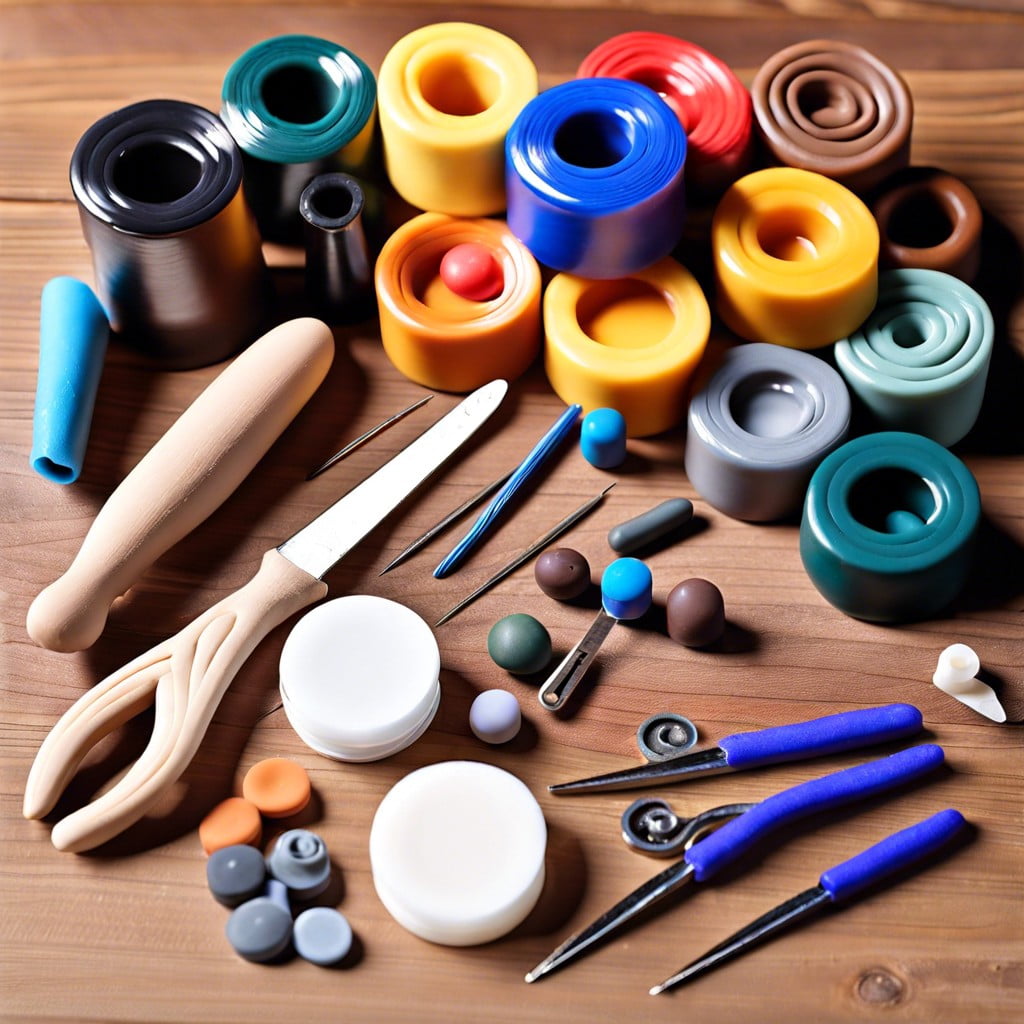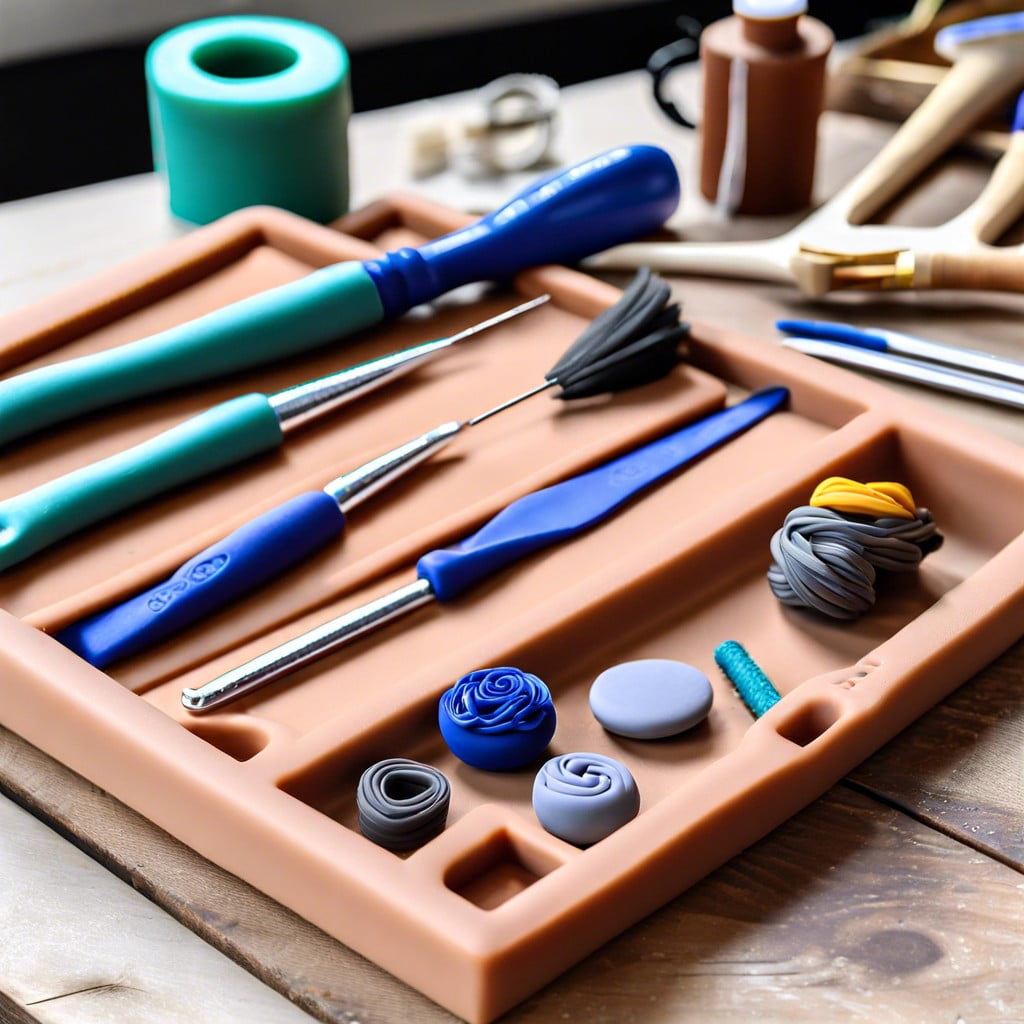Exploring the wide variety of polymer clay tools becomes truly fascinating because of their direct impact on the precision and aesthetics of your art project.
Diving into the world of polymer clay artistry demands not only creativity but also the right set of tools to bring your visions to life. Whether you’re a beginner sculptor eager to set a solid foundation or an experienced artist looking to refine your craft, understanding the essential tools—from durable work surfaces and reliable ovens to precision blades and intricate stamps—can transform your clay endeavors.
As a jewelry maker, your needs might steer towards specialized cutters and texture sheets that add that perfect touch to your wearable art. In this guide, you’ll uncover a curated list of must-have tools and advanced equipment designed to enhance accuracy, detail, and the overall quality of your polymer clay projects, ensuring that every piece reflects your skill and passion.
Key takeaways:
- Polymer clay tools enhance precision and detail.
- Beginner toolkit essentials: surface, lighting, storage, oven, ventilation.
- Essential tools: rolling tools, blades, molding tools, extruders, stamps.
- Advanced additions: pasta machine, texture tools, carving tools, rotary tool.
- Jewelry makers: precise cutters, molders, texture sheets, findings.
Benefits of Having Polymer Clay Tools

Proper polymer clay tools enhance the precision and detail of your projects. With specialized tools, tasks like blending colors, creating textures, and cutting clean shapes become more manageable and more enjoyable. These tools can also speed up the crafting process by providing shortcuts to achieve consistent results. Additionally, using the right tools reduces the physical strain on your hands, making your crafting experience more comfortable, especially during long sessions. Investing in a set of tools tailored to polymer clay work ensures that your creations attain a professional finish, showcasing your skills and artistic vision.
Beginner Polymer Clay Tool Kit: Setting Up Your Work Area

To create an effective workspace for molding and shaping polymer clay, consider the following essentials:
Surface: Opt for a smooth, nonporous surface like glass, ceramic tile, or marble to roll out and shape your clay without it sticking or picking up unwanted textures.
Lighting: Good lighting is crucial. A desk lamp with an adjustable arm can help you see fine details and ensure even color blending.
Storage: Keep your tools and clay organized. Stackable containers or drawers are perfect for separating colors and storing cutters, rollers, and other tools, preventing dust from settling on your work materials.
Oven: Polymer clay needs to be cured, and a dedicated toaster oven is ideal to avoid any cross-contamination with food and to maintain a consistent temperature.
Ventilation: Make sure your workspace is well-ventilated, especially when baking clay, as some types can emit fumes at high temperatures.
Protective gear: Have gloves and eye protection handy to keep your hands clean during the mixing of colors and to protect your eyes from any particulate matter when sanding.
By setting up your work area with these points in mind, you’ll ensure a clean, safe, and efficient environment for bringing your polymer clay creations to life.
Beginner Polymer Clay Tool Kit: Working With Your Clay
When creating with polymer clay, having the right tools at your fingertips streamlines the process and enriches your crafting experience. Here’s a quick glance at some essentials:
Rolling Tools: Smooth out clay with an acrylic roller or pasta machine for even thickness.
Blades: Use a tissue blade to cut and create clean edges, or a needle tool for fine details.
Molding Tools: Rubber-tipped tools, also known as shapers, allow for sculpting and adding texture.
Extruders: For consistent shapes like ropes or hair, an extruder is exceptionally useful.
Stamps and Texturing Tools: These bring tactile elements to the surface of your clay, making your work pop.
Baking Tray and Oven Thermometer: Properly cure your creations on a dedicated tray, and use a thermometer to ensure accurate baking temperatures.
Work Surface: A smooth, non-stick surface such as glass or ceramic tiles protects both your work and your table.
Each tool has a purpose and enhances your ability to manipulate the clay, adding detail, texture, and structure to your projects. As you grow in your craft, you’ll find which tools best suit your technique and style.
Advanced Additions to a Polymer Clay Tool Kit
As you continue to explore and master the art of polymer clay, enhancing your toolkit with specialized items can greatly expand your creative reach. Precision is key at this stage, thus adding a pasta machine is a wise move. It uniformly conditions the clay to the perfect thickness, a task that manual rolling struggles to achieve.
Texture tools also prove valuable, allowing you to imprint intricate designs and patterns into the clay. These might include texture sheets or rubber stamps specifically designed for use with polymer clay. Another asset is silicone molding putty which can be used to create custom molds from any object, granting you the freedom to replicate shapes and designs with ease.
For sculptors, a set of carving tools is indispensable. These fine instruments let you add detail and texture that fingers or larger tools cannot manage. Additionally, consider investing in a set of armature wire and aluminum foil to create internal supports for larger or more complex pieces, ensuring proper structure and stability.
A rotary tool with various attachments offers multiple functions such as sanding, buffing, and drilling, bringing a professional finish to your creations. Such a versatile tool can cut back significantly on the time and effort required for these finishing touches.
Lastly, a dedicated polymer clay oven may be beneficial for those who want to ensure their projects are cured at precise and consistent temperatures, although it’s not mandatory as a well-monitored home oven can suffice. Remember, as you advance, the tools should complement and improve your technique, quality of work, and enjoyment of the craft.
Polymer Clay Accessories and Tools for Jewelry Makers
Precise cutters, molders, and texture sheets expand artistic possibilities, letting jewelry makers create intricate patterns and shapes. Silicone molds offer a means to form consistent, detailed pendants or charms while texture sheets impress designs onto surfaces for enhanced visual appeal.
Needle tools and clay blades are invaluable for making fine cuts and adding delicate details, essential for crafting small-scale items like earrings or brooches. Using a roller or a pasta machine ensures uniformly flat sheets, achieving a professional finish with minimal effort.
Extruders enable the creation of complex shapes and strings of clay, granting artists the ability to fashion beads or filigree effects effortlessly. As finishing touches, sanding blocks help smooth surfaces, and a buffing wheel or hand-held drill adds shine, elevating the final product.
Lastly, incorporating various findings, such as earring hooks, jump rings, and clasps, allows for easy assembly and functionality of the jewelry pieces.
Cleaning Your Polymer Clay Tools
Maintaining the cleanliness of your tools is crucial for ensuring a smooth workflow and pristine projects. Residue from polymer clay can affect the quality of your work when switching colors or applying intricate details.
Here’s how to keep your equipment in top condition:
- Wipe Down with Baby Wipes: For an immediate clean, a simple wipe down with a baby wipe can remove fresh clay.
- Soak in Rubbing Alcohol: For a deeper clean, soak metal tools in rubbing alcohol for a few minutes, then wipe them clean. This method disinfects as well.
- Use Mild Soap and Water: For most tools, washing with mild soap and warm water works well. Be sure to dry thoroughly to prevent rust on metal parts.
- Scrape Off Dried Clay: For stubborn clay residue, gently scrape it off with a craft knife or an old credit card.
- Sand Wooden Tools: If wooden tools start to become rough or discolored, lightly sand them back to a smooth finish.
Remember to clean your tools regularly to prolong their life and improve your crafting experience.
FAQ
What tools do you need to work with clay?
To work with clay, essential tools include a needle tool, a metal or wood potter’s rib, a wire cutting tool, trimming loops, and a sponge.
What can I use for polymer clay?
Materials ideal for polymer clay use include marble, glass, ceramic tile, cardstock, index cards, wax paper, and parchment paper.
How does the type of polymer clay influence the choice of tools?
The type of polymer clay influences the choice of tools as it determines the hardness, workability, and texturing needs, mandating varying degrees of precision and tool strength.
What safety precautions are necessary when using polymer clay tools?
Ensure to use polymer clay tools in a well-ventilated area, always wear gloves to prevent direct skin exposure, and avoid eye contact or ingestion, while keeping these tools out of children’s reach.
Are there specialised tools for creating intricate designs with polymer clay?
Yes, specialised tools such as clay extruders, texture sheets, and carving tools are used for creating intricate designs with polymer clay.
Recap




